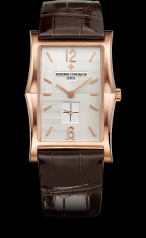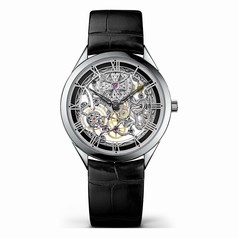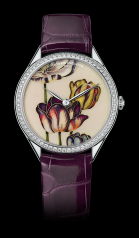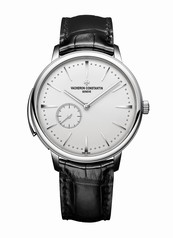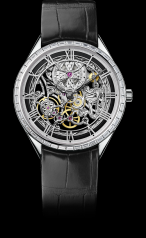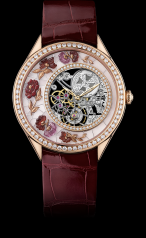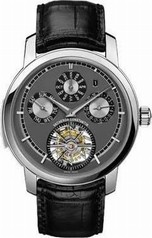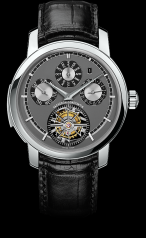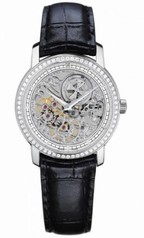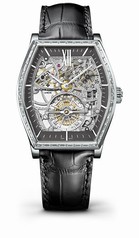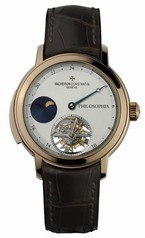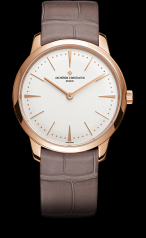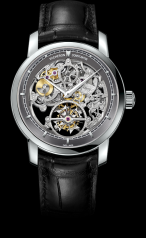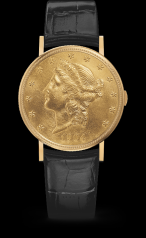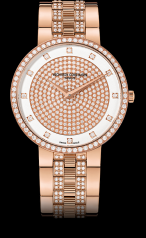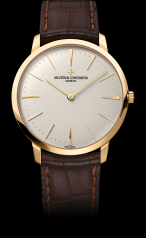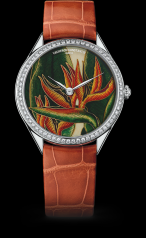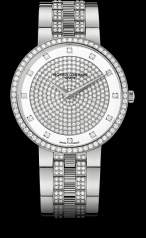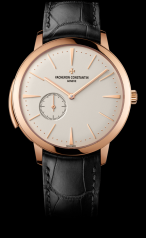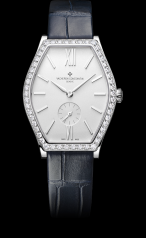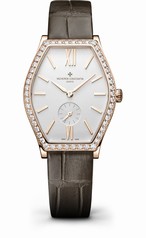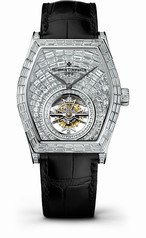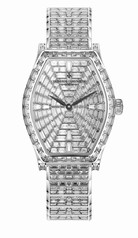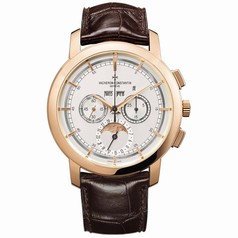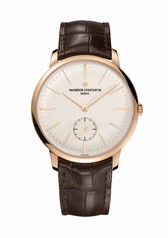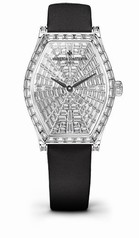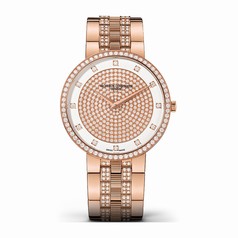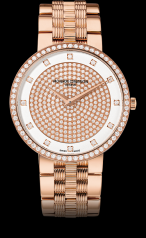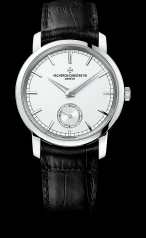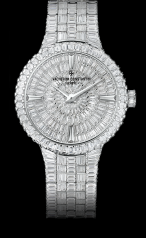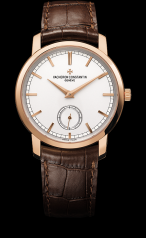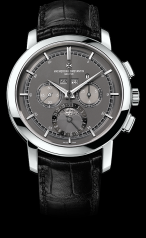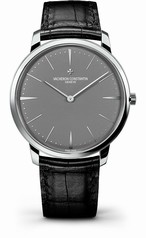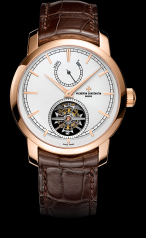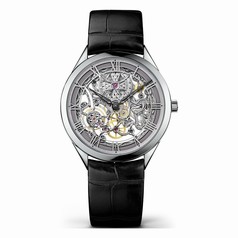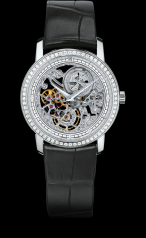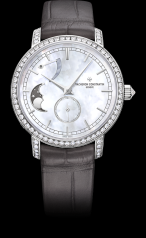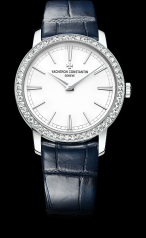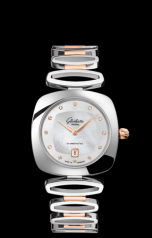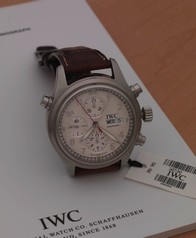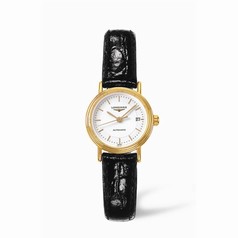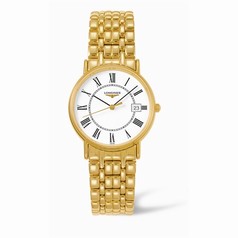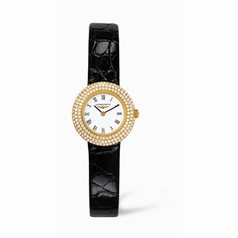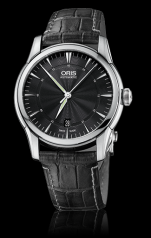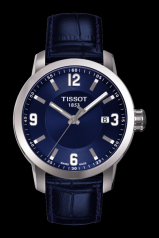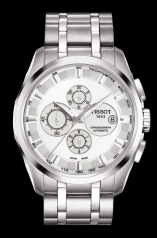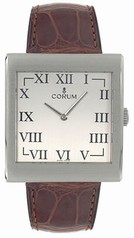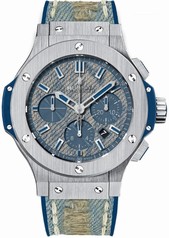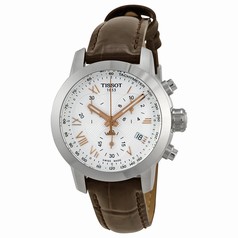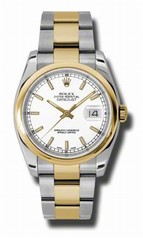-
Vacheron Constantin - Metiers d'Art Mecaniques Ajourees, black enamelled ring
Through its new creations, Vacheron Constantin weaves subtle ties between two worlds that evolved in similar ways in the late 19th century: architecture and watchmaking. Based on Calibre 4400, this sculptural work with its airy, transparent and finely arched construction exalting the art of openworking vividly evokes the large European railway stations symbolising the golden age of the industrial revolution. The engraver's technique is reinvented to resemble that of the sculptor; Grand Feu enamelling completes the piece.
As the railway network developed in the 19th century, the major European stations of the time become the symbol of a world of accelerating exchanges and cultural interchange. It was indeed time to offer travellers a common point of reference, and large central clocks began setting the pace for railway station activity, featuring large and easily readable Roman numerals. The architecture of these buildings literally standing for progress also underwent major changes dictated by both aesthetic and technical considerations. The massive, solidly built initial premises made way for more airy constructions featuring Gothic inspired arches and streamlined ribbed vaults.
Also symbolising time in motion, horology underwent a similar evolution. The imposing pocket-watch calibres were gradually slimmed down by dint of long and patient work on reducing the size of components in terms of both diameter and thickness. The aspiration towards a more airy style gave rise to the first 19th century openworked watches reflecting an approach similar to that governing the architecture of the period: a will to reconcile aesthetic and technical concerns.
An historical quest
While the first entirely openworked Vacheron Constantin calibre appeared in 1924, the Manufacture was a pioneer in this field of stylistic research, since the first watch produced by Jean-Marc Vacheron in 1755 already featured an openworked and engraved balance-cock. Over the following years, the Manufacture relentlessly pursued this quest for mechanical transparency, as it produced movements comprising ever more finely fashioned components. After pocket-watches, it began producing openworked movements for wristwatches as of the 1960s, constantly pushing the boundaries of its art by openworking such complicated calibres as minute repeaters, perpetual calendar and tourbillons - including in ultra-thin variations.
New milestones in the art of engraving
Openworking a movement is a demanding art, since it involves hollowing out the mechanical parts as much as possible, while being careful not to impair the smooth running of the watch. The watchmakers and artisans of the Manufacture compounded the feat of removing almost half the material compared with the solid Calibre 4400 by addressing another challenge: that of transforming the new movement into an authentic three-dimensional architectural work expressing striking light and shadow effects. To achieve this, the engraving artisans have carefully chased the parts around their entire circumference so as to create a true sculpture with its own volume and depth. Inspired by the ribbed vaults of late 19th century railway stations, they have meticulously applied their burins to creating delicate arches on the calibre in an architecture built around curves. These rounded shapes are a complete change from the straight lines of classic openworked movements, and imply an even more complex process of chamfering and hand-drawing. Amid an interlacing pattern of interior angles that only the human hand is capable of creating, the polished zones catch the light, while the matt finish of the hand-drawn surfaces further heighten the contrast with the radiance of the polished areas. The subtle alchemist's blend of these hand-crafted finishes is further exalted by the relief effect of the engraved vaults in a process involving over three days of work for a single calibre and endowing it with unique character.
Grand Feu enamelling
The in-house enamelling artisans have created a ring topping the calibre by dint of meticulous work, since the circular shape of the ring to be enamelled implies substantial risks of distortion. This perilous exercise was compounded by a further difficulty: that of achieving one of the shades most difficult to create with Grand Feu enamel: a deep and opaque black. This was a daunting challenge, since the darker the colour, the more the light reflects even the slightest imperfections. To render the full beauty of this black hue, the master enamellist had to create a perfectly smooth and uniform surface so as to avoid the appearance of any undesirable bubbles during the successive firings of the enamel.
The Grand Feu enamelled black ring is accentuated by Roman numerals evoking those of the central clocks in the large railway stations of late 19th century Europe.
Hallmark of Geneva
Beating at a frequency of 28,800 vibrations per hour, Calibre 4400SQ displays remarkable precision and offers 65-hour power reserve.
The entire model is certified by the Hallmark of Geneva.
-
Vacheron Constantin - SIHH 2014 - The art of openworking
Openworking is a Vacheron Constantin speciality. At the crossroads between complicated horology and artistic craftsmanship, this technique is one of the Geneva-based manufacturer's long-established classics. Its 2014 collection is almost entirely built around the art of trimming, hollowing and engraving movements. Mechanical lacework reigns supreme in a variety of simple, complicated or delicate watches.
A leading exponent of so-called "artistic craft" watches, Vacheron Constantin is inaugurating a new aesthetic theme, christened Fabuleux Ornements. Combining gem-setting, sculpture enamelling and engraving, this collection of four ladies' models features decorative motifs from four different cultures on models respectively named "French Lace", "Chinese Embroidery", "Indian Manuscript" and "Ottoman Architecture". These colourful and refined creations showcase one of the brand's major movements, Calibre 1003. This ultra-thin mechanism is delicately openworked and revealed through an off-centred opening, leaving a crescent-shape space where the fabulous ornamental techniques are displayed.
The stage-setting for an openworked calibre can also be more masculine and monochrome, as exemplified in the new Metiers d'Art Mecaniques Ajourees line that extends the openworking on the Manufacture-made Calibre 4400SQ all the way through to the exterior elements. These 40 mm white gold cases are indeed fitted with a grid-like structure serving to provide the hour and minute indications. So as not to mask the openworking of the movements, there is no dial but instead this chapter ring comprising cut-out Roman numerals appearing against a grand feu enamelled background that comes in a choice of black, grey or blue - the latter two colours being exceptional rare in this type of enamelling.
The historical and cultural sources of openworking devote fundamental importance to highlighting the movement architecture. It is this principle that guides the attention lavished by the decoration artisans of the Manufacture Vacheron Constantin on two particular models. The first is the new version of the Malte Tourbillon Openworked. Its Calibre 2790SQ drives a date display at 2 o'clock facing the large and elaborately crafted tourbillon carriage. The second is a trimmed-down version of one of the major Grand Complication models by Vacheron Constantin. Calibre 2260 with tourbillon and 14-day power reserve has also been finely skeletonised. Framed by a 42 mm Patrimony Traditionnnelle case in platinum, it reveals its two large barrels along with a wealth of intricate engravings.
As well as being finely wrought and engraved, ornamental or complicated, all these new models from Vacheron Constantin bear the Poinçon de Geneve or Hallmark of Geneva - meaning that they all meet the highest standards of craftsmanship on both technical and aesthetic levels, applied to both the movement and the exterior.
Moreover, Vacheron Constantin is also known for its accomplishments in the field of High Jewellery watches. Two models presented at this SIHH 2014 have been entirely adorned with diamonds. The Patrimony Traditionnelle High Jewellery is an exquisitely feminine and precious watch in a dainty 30 mm size; while no less than 400 diamonds clothe the dial and large-size case of the Malte Tourbillon High Jewellery, ensuring it appeals to both men and women. Both are designed to dazzle all those who gaze on the brand's display cases.
-
Vacheron Constantin - 1972 Prestige
Vacheron Constantin's 1972 collection has been making an impression for over four decades. Today, there is a new men's version of this timeless icon inspired by the original. Like the 1972 creation, the most recent arrival displays the balanced asymmetry that strictly follows the proportions of the golden section. Made of white gold, the new 1972 Prestige also houses a precious ultra-thin mechanical movement. A model of sophistication and elegance, this new icon bears the Poinçon de Geneve.
Some timepieces are born under a lucky star and destined to change history. Vacheron Constantin's 1972 model is definitely one of these. On June 23, 1972, in the reception rooms of the prestigious Ritz Hotel not far from 2 Rue de la Paix, the Comite de France bestowed the rare and coveted Prestige de la France award on Vacheron Constantin in tribute to the brand's distinctive expertise, acquired through a desire to achieve authenticity, technical perfection, and elegance.
Vacheron Constantin is the first watchmaking manufacture to have been honoured with this award. In celebration of this honour, the Geneva company brought out a wristwatch of astonishingly innovative appearance, with an asymmetrical design that was exceedingly daring for its time. It was made in an extremely limited series, and the back was engraved with the Prestige de la France coat of arms. Since then, Vacheron Constantin has continued to offer this asymmetrical shape in various sizes and proportions, sometimes in ladies' watches and sometimes in men's, such that it has developed into the iconic 1972 collection.
Precious metal and the golden section
The 1972 Prestige hearkens back to its roots in the historic model. It has the same elegance and harmonious proportions, is the same size, and houses - as it did back in the day - a mechanical hand-wound movement. Like the original, the new 1972 is embellished with Prestige de la France engraved on the back. This nod to history, and to one of the countless creative episodes that have been enriching Vacheron Constantin's legacy for over 250 years, is much more than a bold and unusual watch: it is the culmination of a formal study that drew on art and cultural history as the source of the obvious harmony in its evenly distributed proportions.
The 1972 Prestige takes its strength and balance from the principles of the golden section. For example, the dimension of the longest side of the case, divided by the length of the sapphire crystal on the opposite side, equals 1.618 - the famous golden section that appears in several of the greatest successes in the history of art and architecture, from the facade of the Parthenon in Athens to Le Corbusier's Modulor.
This restrained silhouette is further set off by the polished white gold case. The natural reflections emphasise the curving lines and shapes of this elegant timepiece. Like all the models in this collection, the 1972 Prestige has a cambered profile that reiterates the arched dial and sapphire crystal. For a highly sophisticated touch, the grey satin-finished sunburst dial features subtle chevron motifs accentuated by two 18K 5N pink gold dauphine hands.
A legendary calibre
Since its beginnings, the 1972 collection has always housed remarkable mechanical movements. The new 1972 Prestige is no exception, since at its heart beats Vacheron Constantin's Calibre 1003, an extraordinary mechanical movement. While the fact that it is made of gold already sets it apart from most movements on the market, its other features are what have made it truly legendary.
Calibre 1003 was developed starting in 1952 and introduced on the company's two-hundredth birthday in 1955. To this day, it remains the thinnest mechanical hand-wound movement on the market. Considered by many experts to be one of the most beautiful and sophisticated ultra-thin movements, Calibre 1003 has been defying the laws of mechanics for over 50 years. Making it is extremely complicated, and regulating it takes all the expertise of a Fine Watchmaking firm. On this occasion, Vacheron Constantin has chosen to use a revisited version of this calibre. It remains only 1.64 mm thick - still a record for thinness on the market. In contrast, its finishes are more sophisticated than in the early days, because now the bridges and plate are made of 18K gold. Its 117 components work at a frequency of 18,000 vph, and despite its minuscule size it has a power reserve of over 30 hours. It is meticulously finished: applying the Côtes de Geneve motif, circular graining and bevelling of the components, and drawing of the steel parts is all done entirely by hand.
Today, the extreme slenderness of Vacheron Constantin's Calibre 1003 is paired with the 1972 Prestige model in service to a new stylistic expression, emboldened by the asymmetrical white gold case (waterresistant to 30 metres) and brown alligator leather strap. As a fitting final touch to an exceptional piece, the 1972 Prestige bears the famous Poinçon de Geneve (Hallmark of Geneva).
A limited edition of 40 for special Boutiques
The same is true of a second version of this 1972 Prestige, which is styled with more contrast in shades of black and white. Unveiled for the opening of Vacheron Constantin's new Paris shop at 2 Rue de la Paix, it is offered in a limited edition of 40 pieces as a boutique exclusive. Extremely sophisticated, it stands out for its shining silvered dial and glossy black strap and naturally also has all the other features that make the 1972 Prestige an exceptional watch in every way.
-
Vacheron Constantin - Haute Horlogerie's Feminine Side
WORLDTEMPUS - 8 February 2013
Illustrious botanists such as Sweden's Carl Linnaeus (1707-1778) and Britain's Thomas Martyn (1735-1825) and Dr. Robert John Thornton (1768-1837) came of age during a time when artists and botanists worked together under royal patronage to describe, illustrate and celebrate newly discovered botanical wonders. The former two influenced the latter so that he created the "Temple of Flora", the most enterprising section of a work he called the "New Illustration of the Sexual System of Linnæus," - which today ultimately inspired the magnificent Metiers d'Art Florilege collection by Vacheron Constantin.
Thornton's reference work inspired a modern composition by Vacheron Constantin more than two centuries after it was published. Consisting of almost 90 plates by top botanical illustrators and painters of the time like Peter Henderson, Philip Reinagle and Abraham Pether, it has become inextricably entwined with the history of botany, eighteenth-century exploration of unknown continents, and the resultant fascination with newly-discovered exotic plant species brought back to Europe.
Vacheron Constantin drew upon the unique expertise of its craftsmen and masterful independent miniature enamel painter Anita Porchet to produce a new opus called Metiers d'Art Florilege, which was created exclusively for the female wrist. A selection of plates from the "Temple of Flora," which was published in 1799, were meticulously reproduced on the dials of 18-karat white gold watches by combining traditional artistic crafts like enameling, guilloche and gem setting. The plates of Thornton's book were perfectly reproduced and adapted to the dials: the Queen watch, embellished with the South African strelitzia plant; the White Lily watch, featuring a reproduction of the Virgin Lily; and the China Limodoron watch, boasting an orchid with a distinctive shape and intense color that symbolizes wealth and refinement.
With amazing realism the flowers are reproduced to their smallest detail on three cloisonne enamel Metiers d'Art Florilege models fitted with mechanical manually wound Caliber 4400 movements with bridges, base plate and other components beveled and decorated by hand that shows off the kind of workmanship that goes into this outstanding caliber. Limited to a series of 20 numbered collector's pieces per model and boasting a bezel set with round-cut diamonds, Vacheron Constantin reserved an additional and even more special edition of only 5 pieces per model exclusively for its boutiques that can be recognized by the bezel set with baguette-cut diamonds.
Malte Lady
The nineteenth century was an age when a lady was not expected to know the exact time, and still less to inquire of it in society, says Vacheron Constantin. As a consequence of this, the Geneva manufacture decided to create watches as jewelry that came to symbolize the status of their owners. Nevertheless, even at this early time, one of Vacheron Constantin's first women's watches was a quarter repeater produced around 1810: proof enough that watchmaking complications were not only a masculine affair. Around a century later, in 1912, Vacheron Constantin became one of the first watch manufacturers to produce a tonneau-shaped case. Another century later - today - the Malte collection sees the launch of three models in pink and white gold dedicated to women and decorated with diamonds highlighting the curves of the tonneau-shaped cases. Measuring 28.30 x 38.75 mm and housing quartz Caliber 1202, they are slightly curved to ergonomically fit the most delicate wrist.
Patrimony Contemporaine and Traditionelle
For Vacheron Constantin, the Patrimony line is an integral part of a celebration dedicated to women's watches, and home to original creations in the Contemporary and Tradition styles that extol the jewelry-making skills of the manufacture. Its traditional, round case expresses the enduring classic style of this watchmaker. During the SIHH, Vacheron Constantin presented two versions of a ladies watch with a diameter of 36 mm. The first model boasts an opaline, silver-toned dial framed by a bezel decorated with round diamonds, while urban elegance extends its influence to a pink gold bracelet. The diamond-set minute scale, fine applied hour markers and slender hands for the hours and minutes are curved to follow the external curve of the dial itself. The central second hand sweeps over diamonds and gold while the date is displayed at 6 o'clock. The case's display back gives a superb view of self-winding Caliber 2450 developed and manufactured in Vacheron Constantin's workshops. The second model launched within the Patrimony line was paved with almost 800 diamonds, with the icy gems taking over the entire surface of the dial and invading the bezel and the outside of the bracelet. Again, the exceptional mechanical workmanship of Caliber 2460 was on display through the transparent back.
The elegant case of the new Patrimony Traditionnelle for women was shown reinforced by a new case diameter of 33 mm that is literally illuminated by a bezel set with 54 round-cut diamonds. The opaline silver-toned dial has applied hour markers and Dauphine hands made of solid gold. For this collection, Vacheron Constantin chose Caliber 1400, a manually wound movement boasting the Seal of Geneva, and whose finish is done entirely by hand following a tradition passed down through generations since the brand formed in 1755. Flat surfaces are adorned with côtes de Geneve and sharp edges chamfered and polished, even the heads and slits of each screw. Finally, a high jewelry model in a choice of a 35 mm or 40 mm diameter case sparkles with 16.2 ct of baguette-cut diamonds. The Patrimony Traditionnelle High Jewelry is probably Vacheron Constantin's brightest ambassador within this venture set to seduce a new feminine clientele.

